Axesstel MV140N CDMA/PCS CDMA 1xEV-DO USB Modem User Manual Manual
Axesstel Inc CDMA/PCS CDMA 1xEV-DO USB Modem Manual
Axesstel >
Manual
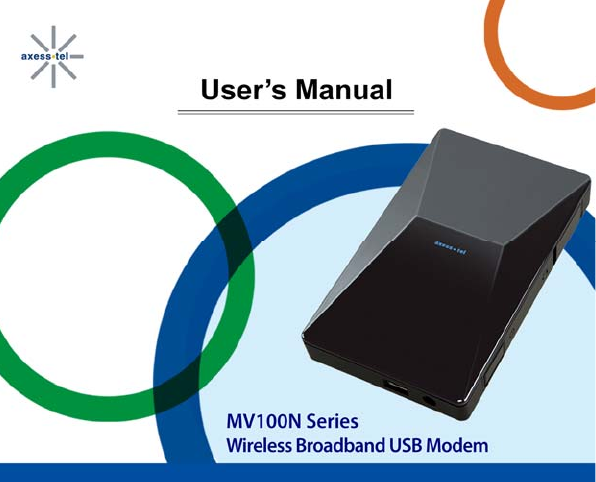

2
INTRODUCTION
Thank you for purchasing the Axesstel MV100-Series Wireless Broadband USB Modem.
This user manual will help you setup, configure and outline best practices for maximizing your
wireless home network performance with the Modem.
The MV100 USB Modems leverage CDMA2000 1xEV-DO Rev A networks to allow mobile
professionals to maintain productivity with secure, high speed access to email, the Internet, data
intensive files and multi-media streaming. Voice calling and SMS messaging enable users to stay
connected to colleagues, customers and family.
A universal USB port allows for quick and easy connectivity to a desktop or laptop PC providing
broadband data access from the home, office or while working remotely. Backward compatibility
ensures services in CDMA2000 1xEV-DO Rev 0 and CDMA2000 1X coverage areas, while internal
receive diversity antennas maximize coverage range and data throughput. The slim and compact
MV100 Series Wireless Broadband USB Modems provide busy professionals with the versatility to
stay productive and connected virtually anywhere, anytime from the home, office or while traveling.

3
FEATURES
1. PC-Based Connection Manager Software with PIM (Personal Information Manager)
Functionality and MS Outlook Phonebook Sync
2. Two Line Color LCD with Status Indicators
3. Receive Diversity for Maximum Range and Throughput
4. Voice and Text Messaging through CDMA2000 1X
5. RUIM Support Optional
6. Internal Li-Ion Battery for additional Transmission Power
7. Phone Book
8. Short Message Service

4
SAFETY PRECAUTIONS
1. Avoid placing the phone in a dusty location, or near a source of gas or fire.
2. Don't Shake, hit or drop the modem.
3. To clean the outside of the modem, use only a soft, dry cloth. The chemicals in alcohol,
benzene or acetone can damage the surface of the modem.
4. Do not twist or pull the Mini-B USB Cable.
5. Do not disassemble the modem.
6. Do NOT use the power adaptor if:
- The power cord is damaged.
- The phone has been dropped or damaged in any way.
7. Frequency and length of use can affect the life of the self-charging battery. Contact your
customer service if the battery is not operating properly.
8. Use only the designated self-charging battery. Dispose of exhausted batteries properly.
Never discard a battery in or near fire or flame.
9. Do not place the modem near water, for example, near a bathtub, sink, wet basement, or
swimming pool.
NOTE 1: The input and output voltages are indicated on the adapter.
(Input: AC 100~240V, 50~60 Hz, Output: DC 5V, 1.2A)
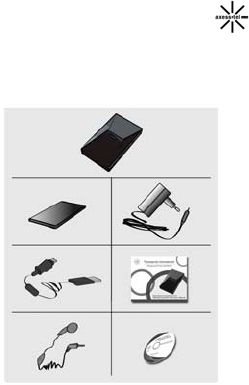
5
CHECKING THE PARTS
Once you have unpacked your phone, make sure that you have all the parts shown below.
If any piece is missing or broken, please call your customer service.
1. Main Unit
2. Li-Ion Battery
3. USB Data Cable
4. Power Adaptor
5. User Manual
6. Ear-mic
7. CD Package for Win98/ME/NT
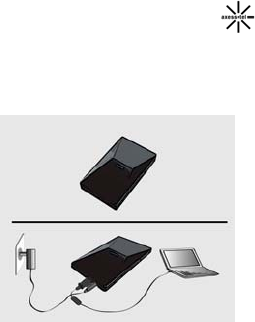
6
GETTING STARTED
Before you can begin using the Modem, you must:
¾ Install the Modem enabling software and driver.
¾ Activate an account and configure the Modem to use your account (unless
the Modem has been pre-activated).
CONNECTING YOUR MODEM TO THE PC
Installing the modem
This modem operates by receiving DC power
from the AXESSTEL power adaptor that
connects to an electrical outlet. The modem is
equipped with a rechargeable battery as a
back up in case of an AC power failure.
Modem installation
1. Plug the smaller end of the adaptor into the
modem as shown and plug the other end
into your laptop’s or PC’s USB port
Note: In case you want to install the driver files (e.g. AxessManager or USB driver files), press and
hold down the ON/OFF button while inserting the USB cable to the PC port. From “My Computer”
window, you will see the modem as another drive (i.e. E: drive or F: drive).

7
INSTALLING THE MODEM SOFTWARE
System Requirements
The system requirements for using this software are summarized below:
(1) Recommended Specifications
CPU: Pentium III 550Mhz or higher, IBM PC-Compatible
RAM: 256MB or more
VGA: Video card with1024 I 768 resolution and 65536 or more colors
HDD: 200MB or more hard disk space
Others: CD-ROM Drive or DVD Drive
OS: Microsoft Windows 2000 or higher (Compatible with Vista version)
(2) Minimum Specifications
CPU: Pentium II 300Mhz or higher, IBM PC-Compatible
RAM: 128MB or more
VGA: Video card with1024 I 768 resolution and 65536 or more colors
HDD: 100MB or more hard disk space
Others: CD-ROM Drive or DVD Drive
OS: Microsoft Windows 2000 or higher
(3) CD Package for Win 98/ME/NT
If O/S version of your PC is Windows 98/ME/NT, you should use CD Package for installation
Of USB Driver and AxessManager.
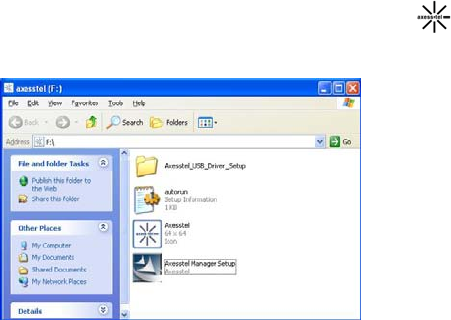
8
Installing the USB Driver and AxessManager
The entire process will take approximately 10 minutes to complete.
Step 1: Press and hold down the ON/OFF button while inserting the USB cable to the PC port.
The above window will appear. Click “Axesstel Manager Setup.exe” to install AxessManager.
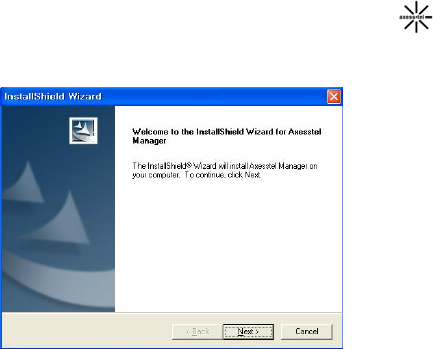
9
Note: If auto-install feature is not available and you don’t see the pop-up window in step 1, click on
“Start” then “My Computer” to see the virtual drive associated with the Modem. Double-click on
that drive to see the pop-up window shown in step 1
Step 2: Click “Next” to continue
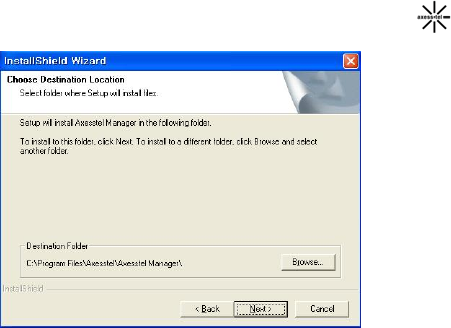
10
Step 3: Click “Next” to continue
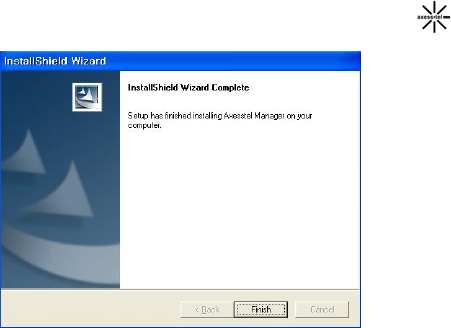
11
Step 4: Click Finish to complete installation of AxessManager
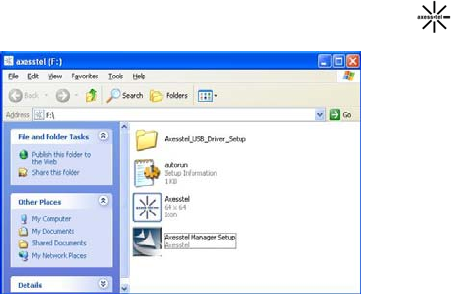
12
Step 5: Click Axesstel Driver Setup folder and select “Install 32” folder
*If you use 64bit OS, please run “MSP_Install64.exe” under “Install 64” folder.
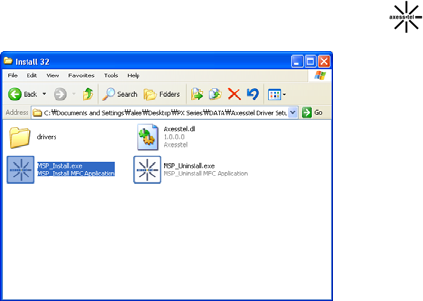
13
Step 6: Click MSP_Install.exe to install USB Driver
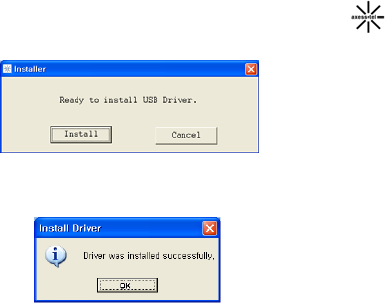
14
The following screen will appear
Step 7: Click Install
Step 8: After finishing driver file copy, Modem will be change to Modem mode from CD ROM
Mode.
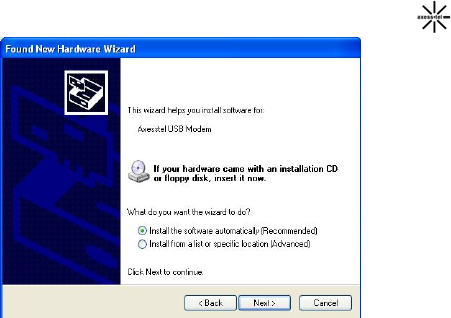
15
Step 9: Axess el USB Mode will be detected on your PC. Select Next to install USB t
Driver.
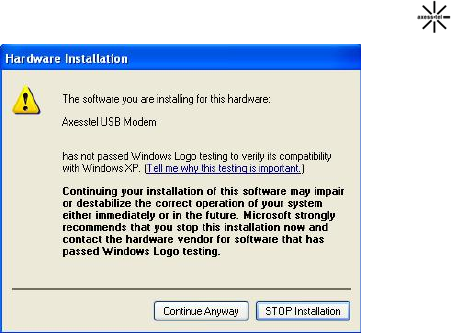
16
Step 10: Select Continue Anyway.
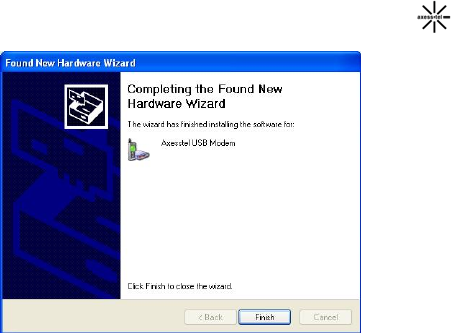
17
Step 11: Select Finish to complete the process
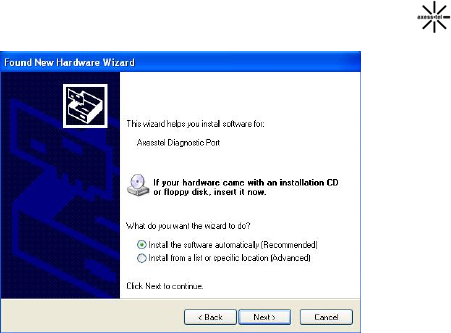
18
Step 12: Axesstel Diagnostic Port will be detected on your PC. Select Next to install
USB Driver.
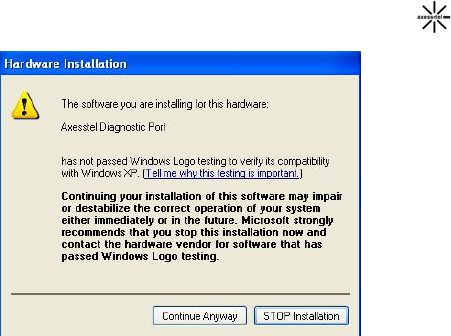
19
Step 13: Select Continue Anyway.
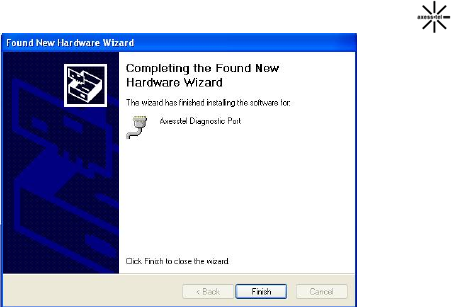
20
Step 14: Select Finish to complete the process. After this step you can start to use
AxessManager
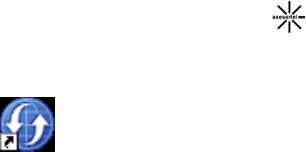
21
Once finished the installation, AxessManager SW utility will appear as a short cut icon in Window.
Axesstel Mana
g
e
r
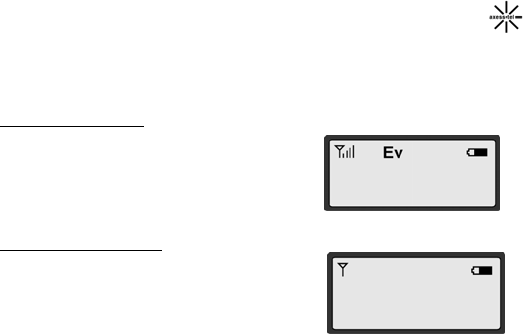
22
QUICK STATUS CHECK
The Modem LCD provides a quick check of its status (services, signal strength, battery level) without
the need to start AxessManager application.
Service Status Check
Display in the Service Area
When the power cord is connected properly, all segments
AXESSTEL
Fri, Feb 3 3:23pm
of the LCD window will turn on briefly. The number of bars
of signal strength indicator (antenna icon) indicates the
strength of service signal of the area. The display will show
the greeting with date and time.
You can change the greeting. (See page 32)
Display in area with no service
When there is no service signal detected in your area, no
AXESSTEL
antenna bar appears. Contact your service provider for the
coverage area information. Also check if the antenna is
connected
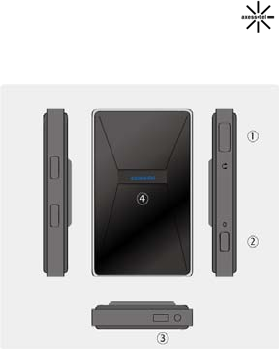
23
GETTING TO KNOW YOUR MODEM
1. Modem Interfaces
1. Audio jack: Standard audio jack for audio
headset. Insert ear-mic to make and receive
voice calls.
2. Power button: Press to turn on / off the
modem and hang up the call. To turn the
modem ON, press and quickly release this
button. To turn it OFF, press and hold the
button 3 seconds then release it. The modem
will turn off after 1 sec.
3. Accessory Connector Part: Insert battery
charger and Mini-B USB Cable.
4. Main Display Window: Shows Status of the
Modem. Also, if the Modem is in a voice call,
Caller ID and other call-related messages
appear here.
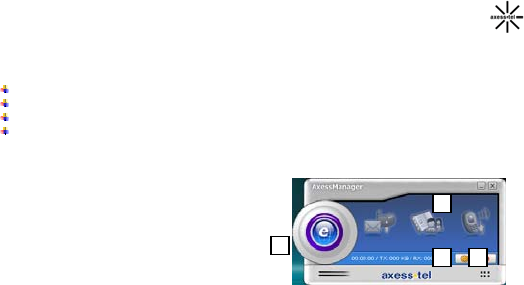
24
2. AxessManager GUI
AxessManager is a SW utility that allows the administration of your Modem. You use
AxessManager to:
Initiate data or voice calls
Manage Personal Information such as Contact list and phonebook
Receive and send SMS messages
Customize features and options
1. Change Mode Button: Change to Manager Mode 4
from Data Connection Mode.
2. Option Button: Change options of Modem such 3 2 1
as SMS setting, phone settings etc.
3. Connection Button: Connect via your operator’s
network
4. Utility Managers: PIMS, SMS and CALL Manager. Only available after you press the Change
Mode button. The image color will change to signal that you can now access the utilities.
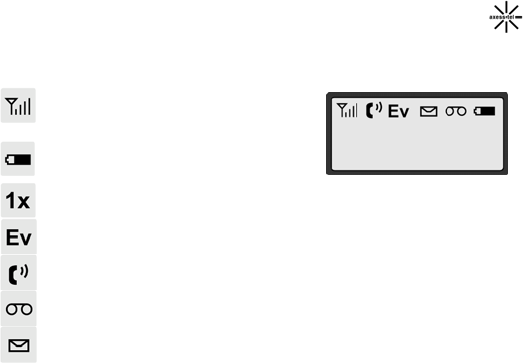
25
DISPLAY ICONS
Icons display on the screen to indicate what features you are using, e.g. signal strength,
battery status and etc...
Indicate the strength of the signal. More bars
Indicate stronger signal.
AXESSTEL
Fri, Feb 9 5:24P
Indicate the level of battery power. The more bars,
The more power. When the battery is low, the icon
blinks, and an alert tone sounds.
Indicates that you are using CDMA 2000 1X Network.
Indicates that you are using 1x EV-DO Network.
Indicates that a voice or data call is in progress
Indicates that you have waiting text messages
Indicates that you have voice mail message

26
AxessManager Operation Guide
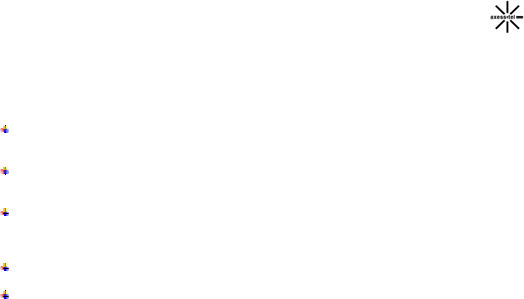
27
1. Getting Started
When the PC and modem are connected via the USB cable, AxessManager allows you to browse
internet, modify modem configurations. In addition, you can perform management tasks for phone
numbers such as adding, modifying and deleting them, and you can write messages in your PC and
send them to your modem.
AxessManager provides the following 5 action-buttons that lead to corresponding menus:
Internet Connection: Internet Connection button allows you to connect to the internet
through your service provider.
PIMS Manager: You can manage phonebook in your PC. Outlook contacts data can be
imported or exported.
SMS Manager: You can download the Inbox, Outbox, and Draft Box messages in your phone
to your PC and edit them, or upload newly created messages to your modem and send them
to others.
CALL Manager: You can make/receive a phone call. Call history can be managed.
Options: You can manage modem settings
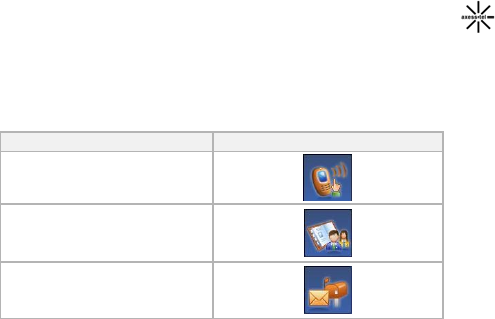
28
1.1. Basic User Interface
1. Connect/Disconnect Button: Used to Connect/Disconnect PC and Phone.
2. Manager Menu: Manager Menu allows you to conveniently move to each Manager by one click.
The icon of each Manager is displayed, and when you click each Manager icon, the Sub Menu
is displayed in the tree structure
Name Image Button
Call Manager
PIMS Manager
SMS Manager
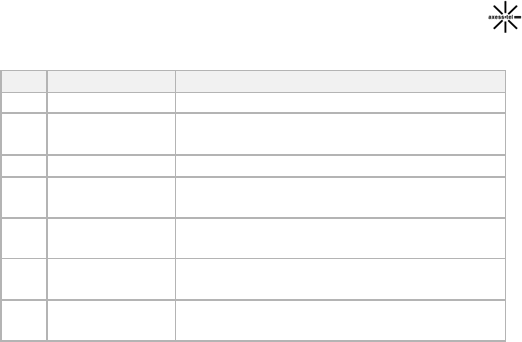
29
3. Menu Bar: The basic menu of AxessManager is provided. The Menu Bar provides the following
main and sub menus:
Name Sub Menu Function
File Open Open a file in the PC for each Manager.
File Save Save a file in the PC in the format supported by each
Manager.
File Exit Exit the AxessManager program.
Tool To PC Send data from Phone to PC when PC and Phone are
connected.
Tool To Phone Send data from PC to Phone when PC and Phone are
connected.
Help About AxessManager The AxessManager program information is displayed.
Help Help The User's Guide for AxessManager is displayed.
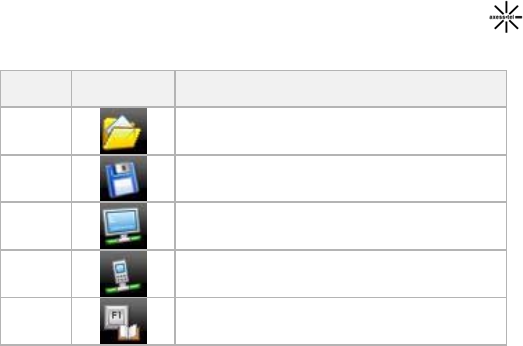
30
4. Toolbar: The frequently used menu items of the Menu Bar are provided as icons. Toolbar
provides the following functions.
Name Image Button Function
Open
Opens a file in the PC for each Manager.
Save
Saves a file in the PC in the format supported by each
Manager.
To PC
Send data from Phone to PC when PC and Phone are
connected.
To Phone
Send data saved in PC to Phone when PC and Phone are
connected.
Help
The User's Guide for AxessManager is displayed.
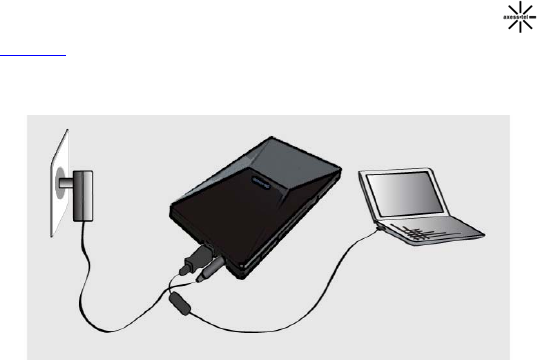
31
1.2. Connecting/Disconnecting Your Modem to/From the PC
Connecting
1. First, connect your PC with the modem using the supplied cable. Insert the cable firmly to
the modem until it clicks into place.
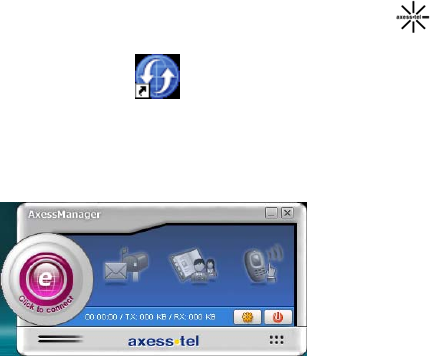
32
1. Click the icon on your desktop to run the AxessManager Program.
Axesstel Mana
g
e
r
2. Click the Connect/Disconnect button. Note that a connection profile needs to be defined and
selected before using the Connect/Disconnect button. Please refer to the section “Add Connect
Item” below for more information. When the connection is successful, you can use the
AxessManager program. All icons will be enabled.
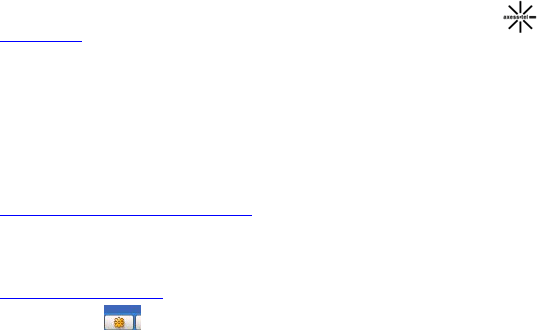
33
Disconnecting
1. Click the Connect/Disconnect button after finishing your job. The connection is discontinued
and the active Connect/Disconnect button is changed to the disabled status. All icons will be
disabled
2. To exit the program after finishing the job, click the button at top right of the program window.
3. Disconnect the cable from PC and modem.
2. Internet Connect
Internet Connection System allows the PC to connect to the internet through network provider with
Axesstel Modem.
1. Internet Connection Connect / Disconnect
1.1. Connect
Once the initial setup is complete, you can use your modem. To make a communication
connection using the modem, click the ‘E’ button on the main screen.
1.2. Disconnect
To disconnect from the communication connection, just click the ‘E’ button on the main screen.
2. Internet Connection Setup
Click the Options button on the main screen of the program to open the following dialog,
where you can specify values for many items needed to set up your modem. The following
screen will appear.
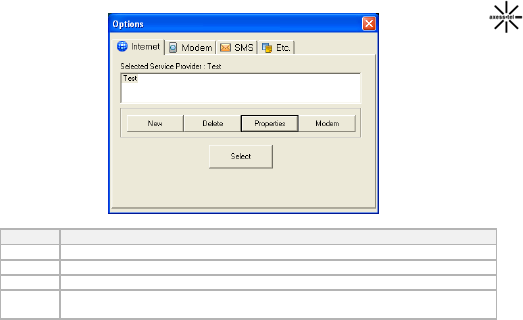
34
A short, functional description for each button on the Setup dialog is provided below.
Button Description
New
A
llows you to add a new 'Connect Item'.
Delete
A
llows you to delete an existing 'Connect Item.'
Properties
A
llows you to modify existing 'Connect Item' settings.
Modem
A
llows you to view and select from a list of modems currently available for
connection.
2.1. Add Connect Item
When you click on the “New” button, the following window appears to ask for connection
parameters
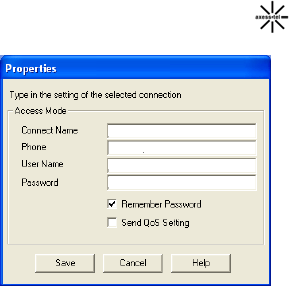
35
(1) Connect Name: Enter the name to be
displayed on the 'Connect Item' list.
(2) Phone: Specify the phone number to
which modem will connect.
(3) User Name: If required, enter the
user ID for the network provider.
(4) Password: Enter the password for the
user name. Select the 'Remember
password' checkbox if you want to
save the password.
(5) Send QoS Setting: If you send the
QoS value specified on the Advanced
Settings window during the connection,
select the 'Send QoS Setting' checkbox.
2.2. Delete Connect Item
Select the 'Connect Item' you want to delete from the 'Connect Item' list in the Setup dialog, and
click Delete. The selected 'Connect Item' will be deleted.
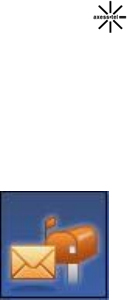
36
2.3. Modify Connect Item
Select the 'Connect Item' you want to modify from the 'Connect Item' list in the Setup dialog, and
click Properties. The following dialog appears, allowing you to modify the settings. See ‘Add
Connect Item' for detailed descriptions about the settings.
2.4. View Modem List
Click Modem in the Setup dialog to open the following Windows default modem settings dialog,
where you can change the modem.
3. SMS Manager
SMS Manager is composed of Inbox for keeping received messages, Outbox
for saving messages that have been sent out, Draft Box for saving messages
that have not yet been sent and Saved Box for keeping important messages
in the Inbox. You can directly send out messages from your PC to your
phone, or download it from phone to PC for more convenient management.
3.1. Inbox Manager
To use Inbox Manager, click the Inbox icon
With Inbox Manager, you can reply to, forward, or delete selected messages.
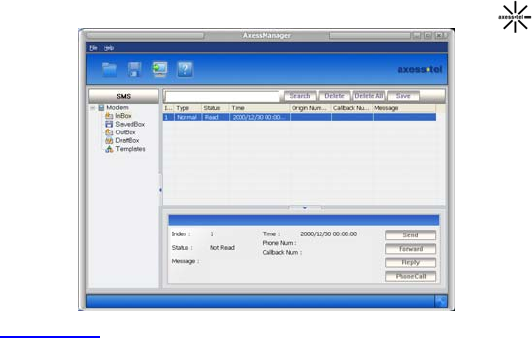
37
1. Inbox List View
(1) By default, Inbox List View shows all Inbox messages saved in the phone.
(2) The details of the Inbox message selected from Inbox List View is displayed in the Preview
window at bottom.
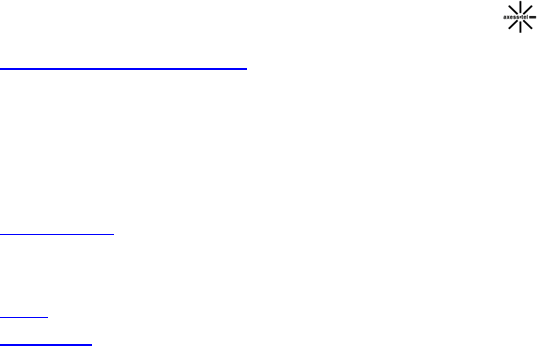
38
(3) You can delete the messages displayed in Inbox List View. (You cannot add.)
2. Preview Window & Reply/Forward (Send)
(1) The details of the Inbox message selected from Inbox List View is displayed in the Preview
window at bottom.
(2) When you click the Reply button in the Preview window, a new window pops up for you to edit the
message and send it to the sender.
(3) When you click the Forward button in the Preview window, a new window pops up for you to edit
the message and send it to the another person.
(4) You can send a message to multiple persons.
(5) Type in the phone number and click the search button to add to the recipients' list.
(6) You can type in the number directly, or click the ok button to open the following window
(7) You can search for existing phone numbers from the contact list.
3. Delete Inbox Data
Select the data to delete and press the Delete key on the keyboard.
To delete multiple data simultaneously, select them with your mouse while pressing down the Shift or
Ctrl key and then press the Delete key. The selected Inbox data is deleted at once from the phone.
The deleted Inbox data cannot be restored.
4. To PC
The Inbox List View is updated with the Inbox messages currently saved in the phone.
5. To Saved Box
Select the data to protect, and press the Save button. The data will be saved in the Saved box.
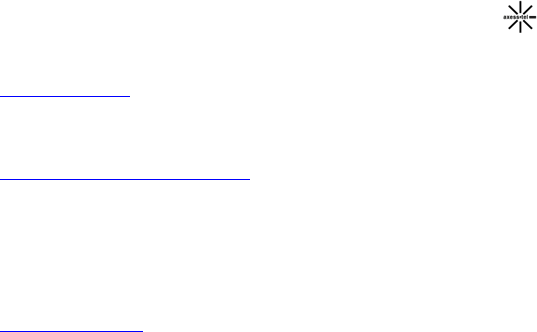
39
3.2. Saved box Manager
To use Saved Box Manager, click the Saved Box icon.
With Saved Box Manager, you can reply to, forward, or delete selected messages.
1. Saved Box List View
(1) By default, Saved Box List View shows all Saved Box messages saved in the modem.
(2) The details of the Saved Box message selected from Saved Box List View is displayed in the
Preview window at bottom.
(3) You can delete the messages displayed in Saved Box List View. (You cannot add.)
2. Preview Window & Reply/Forward (Send)
(1) The details of the Saved Box message selected from Saved Box List View is displayed in the
Preview window at bottom.
(2) When you click the Reply button in the Preview window, a new window pops up for you to edit the
message and send it to the sender.
(3) When you click the Forward button in the Preview window, a new window pops up for you to edit
the message and send it to the another person.
(4) You can send a message to multiple persons.
(5) Type in the phone number and click the search button to add to the recipients' list.
(6) You can type in the number directly, or click the ok button to open the following window
(7) You can search for existing phone numbers from the contact list.
3. Delete Saved Box Data
Select the data to delete and press the Delete key on the keyboard. To delete multiple data
simultaneously, select them with your mouse while pressing down the Shift or Ctrl key and then
press the Delete key.
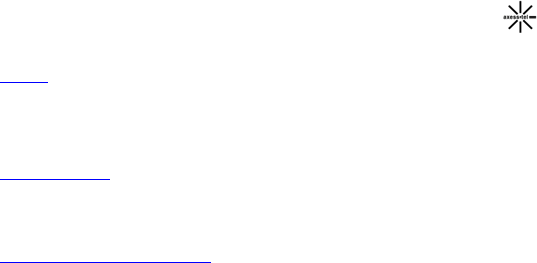
40
The selected Saved Box data is deleted at once from the modem.
The deleted Saved Box data cannot be restored.
4. To PC
The Saved Box List View is updated with the Saved Box messages currently saved in the modem.
3.3. Outbox Manager
To use Outbox Manager, click the Outbox icon With Outbox Manager, you can forward, modify, or
delete selected messages in Outbox.
1. Outbox List View
(1) By default, Outbox List View shows all Outbox messages saved in the modem.
(2) The details of the Outbox message selected from Outbox List View is displayed in the Preview
window at bottom.
(3) You can delete the data displayed in Outbox List View
2. Preview Window & Forward (Send)
(1) The details of the Outbox message selected from Outbox List View is displayed in the Preview
window at bottom.
(2) To write a new message, click the Send button in the Preview window. A new window pops up in
which you can write a new message and send it to others.
(3) When you click the Forward button in the Preview window, a new window pops up for you to edit
the message and send it to the another person.
(4) You can send a message to multiple persons.
(5) Type in the phone number and click the search button to add to the recipients' list.
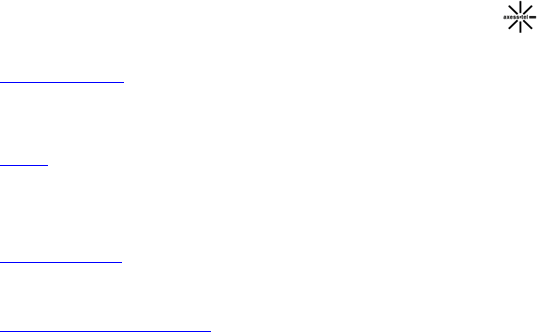
41
(6) You can type in the number directly, or click the ok button to open the following window
(7) You can search for existing phone numbers from the contact list.
3. Delete Outbox Data
Select the data to delete and press the Delete key on the keyboard. To delete multiple data
simultaneously, select them with your mouse while pressing down the Shift or Ctrl key and then
press the Delete key. The selected Outbox data is deleted at once from the modem
The deleted Outbox data cannot be restored
4. To PC
The Outbox List View is updated with the Outbox messages currently saved in the modem.
3.4. Draft Box Manager
To use Draft Box Manager, click the Draft Box icon.
With Draft Box Manager, you can forward, or delete selected messages in Draft Box.
1. Draft Box List View
(1) By default, Draft Box List View shows all Draft Box messages saved in the modem.
(2) The details of the Draft Box message selected from Draft Box List View is displayed in the
Preview window at bottom.
(3) You can delete the data displayed in Draft Box List View.
2. Preview Window & Forward (Send)
(1) The details of the Draft Box message selected from Draft Box List View is displayed in the
Preview window at bottom.
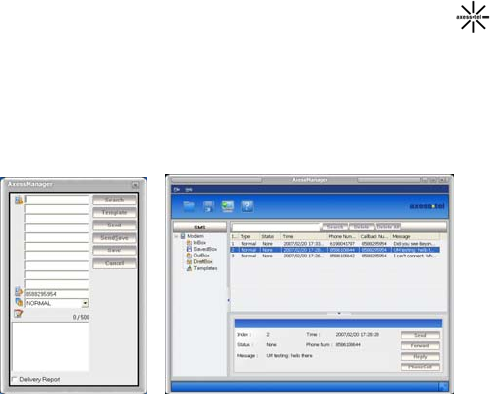
42
(2) To write a new message, click the “New” button in the Preview window, or double click an empty
field in the Draft Box List. A new window pops up in which you can write a new message and
send it to others.
(3) When you click the Forward button in the Preview window, a new window pops up for you to edit
the message and send it to the another person.
(4) You can send a message to multiple persons.
(5) Type in the phone number and click the search button to add to the recipients' list.
(6) You can type in the number directly, or click ok button to open the following window.
(7) You can search for existing phone numbers from the contact list.
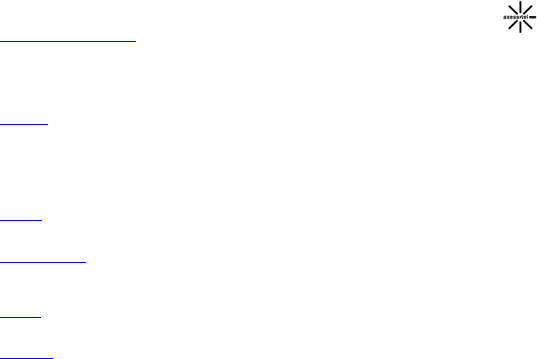
43
3. Delete Draft Box Data
Select the data to delete and press the Delete key on the keyboard. To delete multiple data
simultaneously, select them with your mouse while pressing down the Shift or Ctrl key and then
press the Delete key. The selected Draft Box data is deleted at once from the modem.
The deleted Draft Box data cannot be restored.
4. To PC
The Draft Box List View is updated with the Draft Box messages currently saved in the modem.
3.5. Send
To send a new message, press Send button the Preview window.
A new window will pop up. There are 4 buttons in the Send window.
1. Send
Send the message directly to the recipients through the modem.
2. Send & Save
Send the message directly to the recipients through the modem. The message is also saved in the
Outbox in the modem
3. Save
This button does not send the message. Message is saved in the Draftbox for later use.
4. Search
Search for phone number from the Phonebook.

44
4. PIMS Manager
By using PIMS Manager, you can upload contact data to your modem, or download
it from modem to PC for more convenient management.
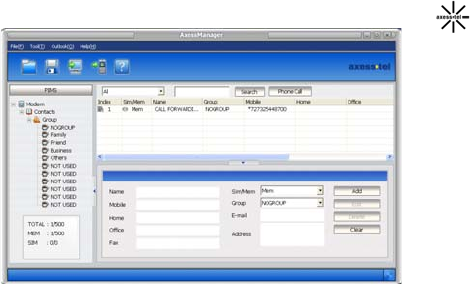
45
4.1 Contacts Manager
By using the contacts, user can enter/change/erase the name, group, telephone numbers (mobile,
home, office), Fax, E-Mail, Address.
Also, user can check the number of SIM's and memories that can be registered, and here the
number of possible registrations varies depending on the kinds of the connected modem.
Therefore, the entries in the contracts can be selectively registered to the SIM and Memories.
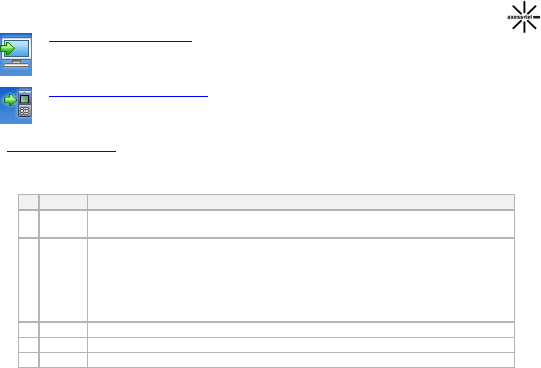
46
1. Upload (Modem
Æ
PC)
After confirmation of successful connection with the modem, select the Tool then PHONEÆ
PC menu from the File menu on the top (Or, click the icon).
2. Download (PC
Æ
Modem)
After confirmation of successful connection with the modem, select the Tool then PC
ÆPHONE menu from the File menu on the top (Or, click the icon).
3. Adding Contacts
For addition of contacts, use the following rules.
(Data field length may vary in different modem models)
No Items Rule
1 Name Number of name depends on SIM card/Modem specifications
2 Phone
No
For phone numbers, up to 20 digits can be entered Including codes such as ‘#’,
‘-‘, ‘*’ in case of saving to SIM.
For phone numbers, up to 40 digits can be entered Including codes such as ‘#’,
‘-‘, ‘*’ in case of saving to Mem.
Particularly, you can insert phone number, home, business, fax number in the
case of Mem.
3 Group When you select Mem, only can use.
4 Email When you select Mem, only can use.(able to insert 50 digit)
5 Address When you select Mem, only can use.(able to insert 50 digit)
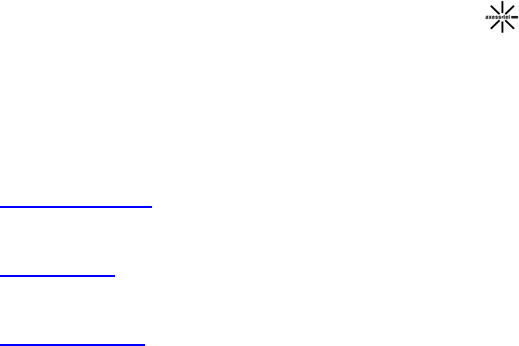
47
Enter at least one digit in the Name and Phone Number
For Phone Numbers: up to 20 digits can be entered including codes such as, '#', '-', '*'. For
Names: When you add data in SIM, the name have a restricted length by SIM and you can only
add mobile number.
Select the SIM/Mem
Select Group, E-mail, and input a desired text in Address (maximum 50 characters). You can
selectively enter the items listed above except Name and Phone Number (at least one phone
number should be input).
Press the Add button after entering necessary information to complete the addition.
To continue adding, repeat the above procedure.
4. Changing Contacts Data
(1) Select the name to be changed from the data list control screen.
(2) After changing and entering items of your choice, press the Edit button to complete the
changes.
5. Deleting Contacts
Select the name to be deleted from the Contacts Data List Control screen.
Also, multiple names can be selected and deleted at the same time just like the Windows. (Shift +
Click for selection of block, Ctrl + Click for accumulating one at a time). Click the Delete button to
delete the data on the chosen phone number.
6. Finding Phone Number
Enter the name you want to find, and then click the Search button.
When it is necessary to find the items continuously, press F3 key.
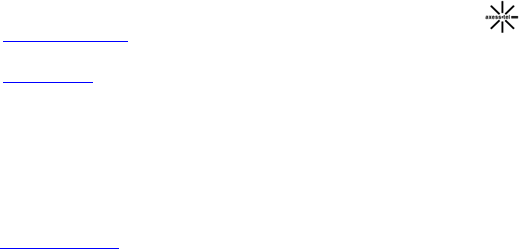
48
7. Arranging Contacts
(1) To arrange the Contacts, click the item on the Phone Number list.
(2) This will make the Contacts arranged with respect to the chosen item.
8. Making a Call
(1) To make an outgoing call, highlight the item on the Phone Number list, and click the Phone
Call button.
(2) This will open the Phone Call Window.
4.2. CSV Conversion
This program not only reads and stores data files but also provides functions that convert the
address book data to CSV files or read the existing CSV files and store them as current program
data files.
In other words, the address book data of Outlook can be loaded in this program and, conversely,
the data of this program can be stored in the address book of Outlook in CSV format.
1. Reading CSV Files
(1) Perform the following steps to read CSV files:
- Select Tool > Read CSV on the menu.
(2) A dialogue box is displayed as follows.
- When the above dialogue box is displayed, click 'Find File' button to select a CSV file stored
in your PC.
(3) Then, a list of data read is displayed on Data List Window that shows the phonebook on PIMS
Manager.
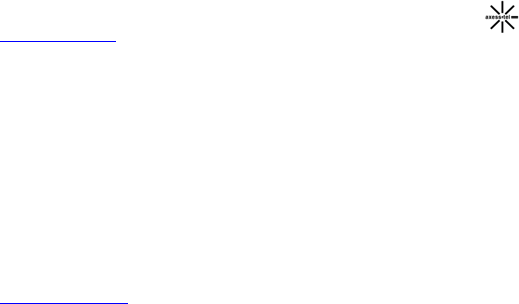
49
2. Writing CSV Files
(1) To store existing data as CSV files, perform the following steps.
- Select Tool> Write CSV on the menu.
(2) A dialogue box is displayed as shown below.
- When the above dialogue box is displayed, click 'Find File' button to specify the directory
to store files in your PC and enter the name of the file to store.
- And under SCV Type, choose whether the CSV files to store are for Outlook.
- When you have chosen the directory and the CSV file names to store and the desired
CSV type, click OK to implement CSV Write.
(3) You can open the CSV files stored as above not only with AxessManager but also with
Outlook and view their contents.
4.3. vCard Conversion
This program also provides functions that convert the address book data to vCard files or read the
existing vCard files and store them as current program data files. In other words, the address
book data of AxessManager can be shared with any other programs that support vCard format.
1. Reading vCard Files
(1) Perform the following steps to read vCard files:
- Select Tool > Import vObject on the menu.
(2) A dialogue box is displayed as follows.
- When the above dialogue box is displayed, click 'Find File' button to select a vCard file
(*.vcf) stored in your PC.

50
(3) Then, a list of data read is displayed on Data List Window that shows the phonebook on PIMS
Manager.
2. Writing vCard Files
(1) To store existing data as vCard files, perform the following steps.
- Select Tool> Export vObject on the menu.
(2) A dialogue box is displayed as shown below.
- When the above dialogue box is displayed, click 'Find File' button to specify the directory to
store files in your PC and enter the name of the file to store.
- When you have chosen the directory and the vCard file names to store, click OK to
implement vCard Export.
(3) You can open the vCard files stored as above not only with AxessManager, but also with
Outlook or other programs that support vCard 2.1 format.
4.4. Outlook Conversion
This program also provides functions to directly import/export address book data to/from the
Outlook. Simply select Import/Export Outlook from the Tool menu, and follow the on-screen
instructions.
Please note that only address book data from Outlook 2000 and above versions may be
imported/exported. Outlook Express is not supported.
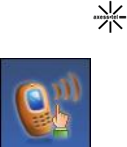
51
5. Call Manager
Call Manager may be invoked from the main window or from the PIMS
manager by pressing “Phone call” button. Both actions will bring up a new
window that emulated a cell phone.
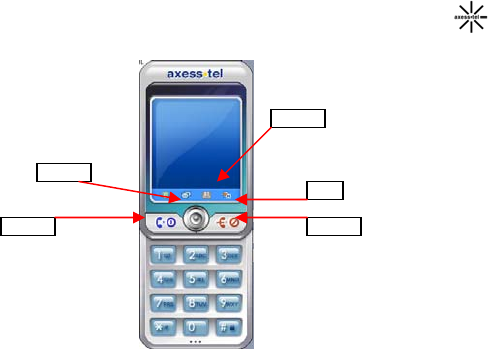
52
CLR
END SEND
PIMS
SMS
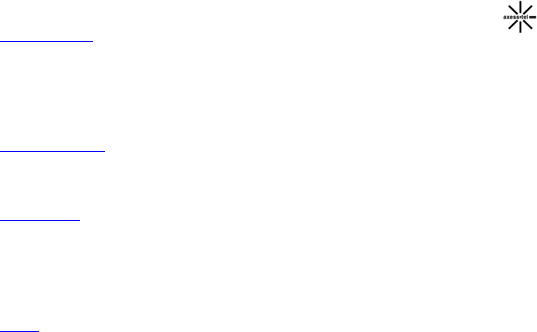
53
1. Making a Call
(1) Press number keypads
(2) Type in numbers directly on the LCD box.
(3) When typing/pressing numbers, press CLR button to erase last number entered, or END button
to clear all numbers
(4) Press the Send button to make a call to the number displayed on the LCD box.
(5) Press END button to hang up the call.
2. Receiving a Call
(1) When a call comes in, Phone Call window will pop up with Caller ID displayed in the LCD box.
(2) Press any key button, except the END key, to receive the incoming call.
(3) Press END button to hang up the call.
3. Call History
(1) Press LIST button to open Call History Window.
(2) Select Incoming/Outgoing/Missed tabs to view each lists.
(3) Double clicking on the list will send phone number to the LCD box.
(4) Select an item from the list and press Delete button to delete the item.
(5) Select a tab, and press Delete All button to delete all items on that list.
(6) Press Reset button to delete all items on all the lists.
4. SMS
(1) Press SMS button to send a message to the number on the LCD box.
(2) SMS Window will be opened, and Send SMS Window will be opened
(if there is a number on the LCD box).

54
(3) Refer to SMS section to send a message.
5. PIMS
(1) Press PIMS button to look up a number in the address book.
(2) PIMS Window will be opened.
(3) Refer to PIMS section to manage phonebook data.

55
Miscellaneous
Specifications
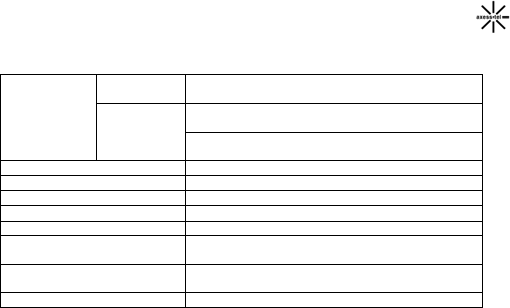
56
SPECIFICATIONS
Frequency
Range
MV110N Rx: 462 ~ 468 MHz
Tx: 452 ~ 458 MHz
MV140N
Rx: 869 ~ 894 MHz
Tx: 824 ~ 849 MHz
Rx: 1930 ~ 1989 MHz
Tx: 1850 ~ 1909 MHz
Channel Bandwidth CDMA 1.25 MHz
Stability of frequency 0.4 ppm
External appearance (mm) 97 x 57 x 19.5 mm
Weight 150 g (with battery)
Sending output maximum 0.23W E.R.P
Temperature of operation
Relative humidity
-20 ~ +50 degrees Celsius
5% ~ 90%
Adapter Input: AC 100~240V 50~60Hz
Output: DC 5V/1.2A
Battery 750mAh, Li-ion
AXT_v4.2
CAUTION: Use Adaptor supplied with Product only

57
SAR INFORMATION
THIS MODEL PHONE MEETS THE GOVERNMENT’S
REQUIREMENTS FOR EXPOSURE TO RADIO WAVES.
Your wireless phone is a radio transmitter and receiver. It is designed and manufactured not to
exceed the emission limits for exposure to radiofrequency(RF) energy set by the Federal
Communications Commission of the U.S.Government. These limits are part of comprehensive
guidelines and establish permitted levels of RF energy for the general population.
The guidelines are based on standards that were developed by independent scientific
Organizations through periodic and thorough evaluation of scientific studies. The standards
include a substantial safety margin designed to assure the safety of all persons, regardless of age
and health. The exposure standard for wireless mobile phones employs a unit of measurement
known as the Specific Absorption Rate, or SAR. The SAR limit set by the FCC is 1.6 W/kg. *
Tests for SAR are conducted with the phone transmitting at its highest certified power level in all
tested frequency bands. Although the SAR is determined at the highest certified power level, the
actual SAR level of the phone while operating can be well below the maximum value. This is
because the phone is designed to operate at multiple power levels so as to use only the power
required to reach the network. In general, the closer you are to a wireless base station antenna,
The lower the power output. Before a phone model is available for sale to the public, it
must be tested and certified to the FCC that it does not exceed the limit established by the
government adopted requirement for safe exposure. The tests are performed in positions and
locations (e.g., at the ear and worn on the body) as required by the FCC for each model.
The highest SAR value for this model modem when tested for use near the body,
as described in this user guide, is 0.597 W/Kg . While there may be

58
differences between the SAR levels of various phones and at various positions, they all meet the
government requirement for safe exposure.
The FCC has granted an Equipment Authorization for this model phone with all reported SAR levels
evaluated as in compliance with the FCC RF exposure guidelines. SAR information on this model
phone is on file with the FCC and can be found under the Display Grant section of ttp://www.fcc.gov/
oet/fccid after searching on FCC ID: PH7MV140N.
Additional information on Specific Absorption Rates (SAR) can be found on the Cellular
Telecommunications Industry Asso-ciation (CTIA) web-site at http://www.wow-com.com. * In the
United States and Canada, the SAR limit for mobile phones used by the public is 1.6 watts/kg (W/kg)
averaged over one gram of tissue. The standard incorporates a sub-stantial margin of safety to give
additional protection for the public and to account for any variations in measurements.
SAFETY INFORMATION FOR RF EXPOSURE
Near Body operation
This device was tested for typical near body operations with the back of the phone kept 2.5 cm
from the body. To maintain compliance with FCC RF exposure requirements, it must have a minimum
distance including the antenna of 2.5 cm from the body during normal operation.

59
Safety Information
1 . SAFETY INFORMATION FOR FIXED WIRELESS TERMINALS
.POTE NTIALLY EXPLOSIVE ATMOSPHERES
Turn your phone OFF when in any area with a potentially explosive atmosphere and obey all signs
and instructions. Sparks in such areas could cause an explosion or fire resulting in bodily injury or
even death.
.INTERFERENCE TO MEDICAL DIVICES
Certain electronic equipment may be shielded against RF signal from you wireless phone.
(pacemakers, Hearing Aids, and so on) Turn your phone OFF in health c are facilities when any
regulations posted in these areas instruct you to do so. RF signals may affect improperly installed or
inadequately shielded electronic system in motor vehicles.
.EXPOSURE TO RF ENERGY
Use only the supplied or an approved replacement antenna. Do not touch the antenna unnecessarily
when the phone is in use. Do not move the antenna close to, or couching any exposed part of the
body when making a call.
FCC Compliance Information
This device complies with Part 15 of FCC Rules.
Operation is subject to the following two conditions:
(1) This device may not cause harmful interference, and
(2) This device must accept any interference received.
Including interference that may cause undesired operation.

60
U.S.A.
U.S.FEDERAL COMMUNICATIONS COMMISSION
RADIO FREQUENCY INTERFERENCE STATEMENT
INFORMATION TO THE USER
NOTE : This equipment has been tested and found to comply with the limits for a Class B digital
device pursuant to Part 15 of the FCC Rules. These limits are designed to provide reasonable
protection against harmful Interference in a residential installation This equipment generates, uses,
and can radiate radio frequency energy and, if Not installed and used in accordance with the
instructions, may cause harmful Interference to radio communications.
However, there is no guarantee that interference will not occur in a particular Installation.
If this equipment does cause harmful interference to radio or television reception, which can be
determined by turning the equipment off and on, the user is encouraged to try to correct the
interference by one or more of the following measures:
*- Reorient or relocate the receiving antenna.
Increase the separation between the equipment and receiver.
*- Connect the equipment into an outlet of a circuit different from that to which the
receiver is connected.
*- Consult the dealer or an experienced radio/TV technician for assistance.
Changes or modification not expressly approved by the party responsible for Compliance could void
the user’s authority to operate the equipment. Connecting of peripherals requires the use of
grounded shielded signal cables
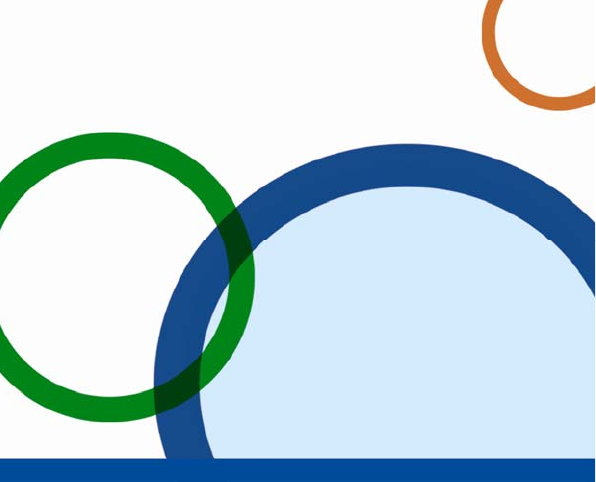
61